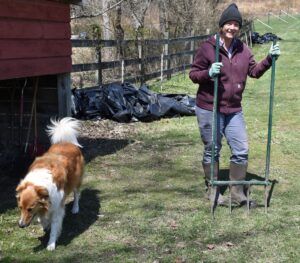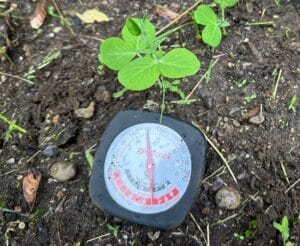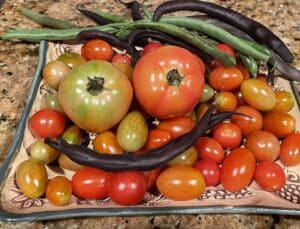Hello, fellow lovers of all things green. I found a few hours to tackle the vegetable garden on Mother’s Day. Finding time for my garden is hard, but it brings me joy when I do. Thankfully, gardens are forgiving. A bit of a save on my delinquency: I planted snap peas a few weeks ago, following the protocol when peepers peep, it’s time to plant peas. Well, after the 10-day anticipated germination period, only about a third sprouted, likely due to the soil temperatures not being warm enough. Taking the soil temperature is more accurate than following folklore, as fun as it is to follow nature to determine when to sow vegetables outside.
Confessions about my No-till Garden
I gingerly removed the chickweed and ground ivy that scrambled upon my no-till garden because I never planted the cover crop in the fall. Nor did I spread the straw as a last-minute remedy. Darn. I carefully removed the plants, trying not to disturb the soil, as we learned in our No-Till Gardening coaching from Patti Doell of Little Big Farm, a cut flower farm in Blairstown, NJ, which I shared a few years ago.

Patti Doell, owner of Little Big Farm (and Buttercup), demonstrates a broadfork used in no-till gardening.
Also known as no-dig gardening, it’s the practice of not disturbing the soil by turning it over. Soil is a living thing with microorganisms, nematodes, fungi, protozoa, and earthworms, which work together to decompose organic matter that nourishes the soil and adds aeration, improving drainage and moisture retention. As a result, not only will plants grow better and produce more, but they’ll also be more resistant to pests and diseases and more tolerant of periods of drought.
I giggled as I worked, as chickweed (Stellaria media) and ground ivy (Glechoma hederacea), also known as Creeping Charlie, are edible. So maybe I was meant to feed on those rather than the tomatoes, zucchini, green beans, and cucumbers I had planned. Humm, it’s best to research and learn more before I forage.
I’ll plant Nasturtium seeds, the annual edible, colorful flowering plant we discussed last week that sports the lotus effect and attracts pests like aphids, keeping them from attacking the veggies. It also deters squash bugs and attracts pollinators, including butterflies, bees, and hummingbirds.
Planting at the right time is essential.

My cooking thermometer works well for checking soil temperatures.
Planting at the right time is as essential as water and nutrients. Following a calendar to determine the right time to plant isn’t always accurate because temperatures vary, as we experienced this year. By the time this column gets to you, we are likely good to go on transplanting starter plants and sowing some seeds directly in the ground, but always best to be sure. Taking your soil’s temperature is the most accurate way.
Many seed packets and plant labels provide the optimum temperature for planting. High-tech thermometers provide digital readings that beep when ready, but an analog soil thermometer for less than ten bucks is just as effective. They work much like the human kind, which would be the in-the-bottom variety, Mom, and RN Nurse, always touted to be the most accurate. Simply stick the soil thermometer probe into your soil about 6 inches for a minute or until Mr. High-tech beeps. You can even use an instant-read thermometer made for cooking.
Ideal soil temperature varies by crop.

Be sure to check your soil temperature at midday for at least three days—average the readings by dividing the total by the number of days taken. And no faking a fever to avoid going to school (smile).
Garden Dilemmas? AskMaryStone@gmail.com and your favorite Podcast App.
There’s more to the story in the Garden Dilemmas Podcast:
Related Podcasts and Blog Posts you’ll enjoy:
Ep 28. Three Sisters, No-Till Gardening
No-Till Gardening and Starting a No-till Garden – Blog Posts
Ep 26. Folklore of Hope – Planting Following Nature
Planting Following Nature and Planting by the Moon – Blog Posts


